|
|
Post by Lee Martin on Mar 9, 2015 20:05:54 GMT -5
Time for a look at a remarkable machine. 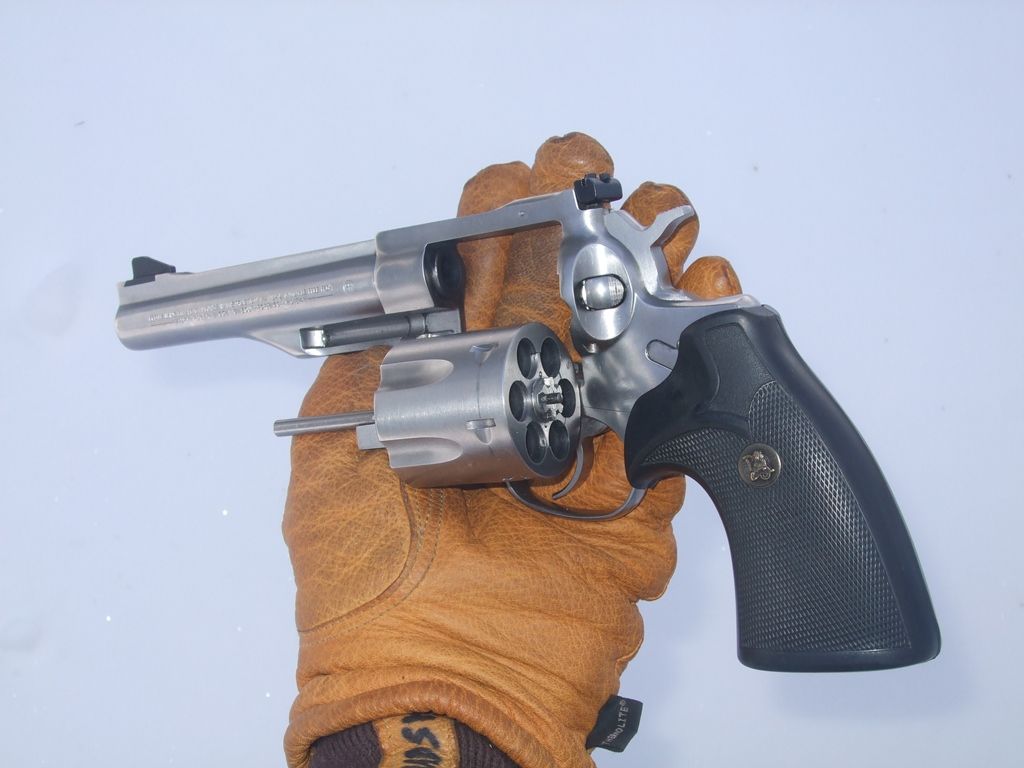 Heart of the Redhawk is a "solid" frame, a term arrived at by the elimination of a sideplate. Without the lost wax or investment casting process invented in China 6,000 years ago, the solid frame would be prohibitively expensive if not impossible to make. The barrel begins as a drop forging, which is machined, gun drilled, reamed, and broach rifled. 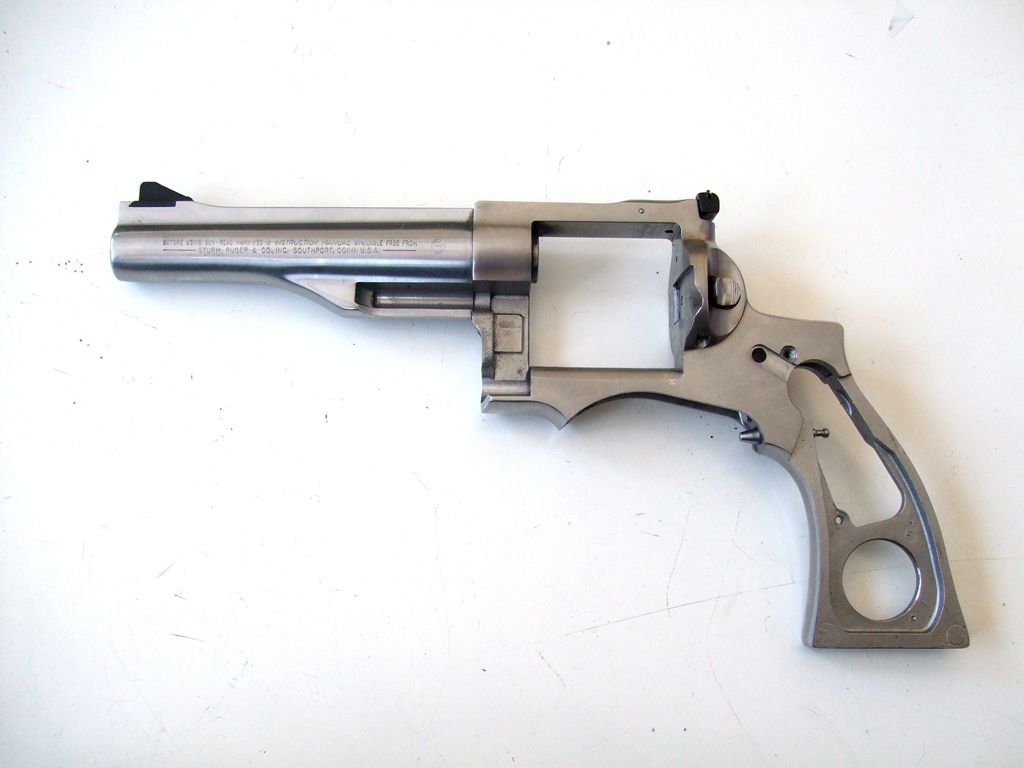 Frame, trigger guard, hammer,. trigger, four of many investment cast parts that make the Redhawk. Frame, hammer & trigger are heat treated. 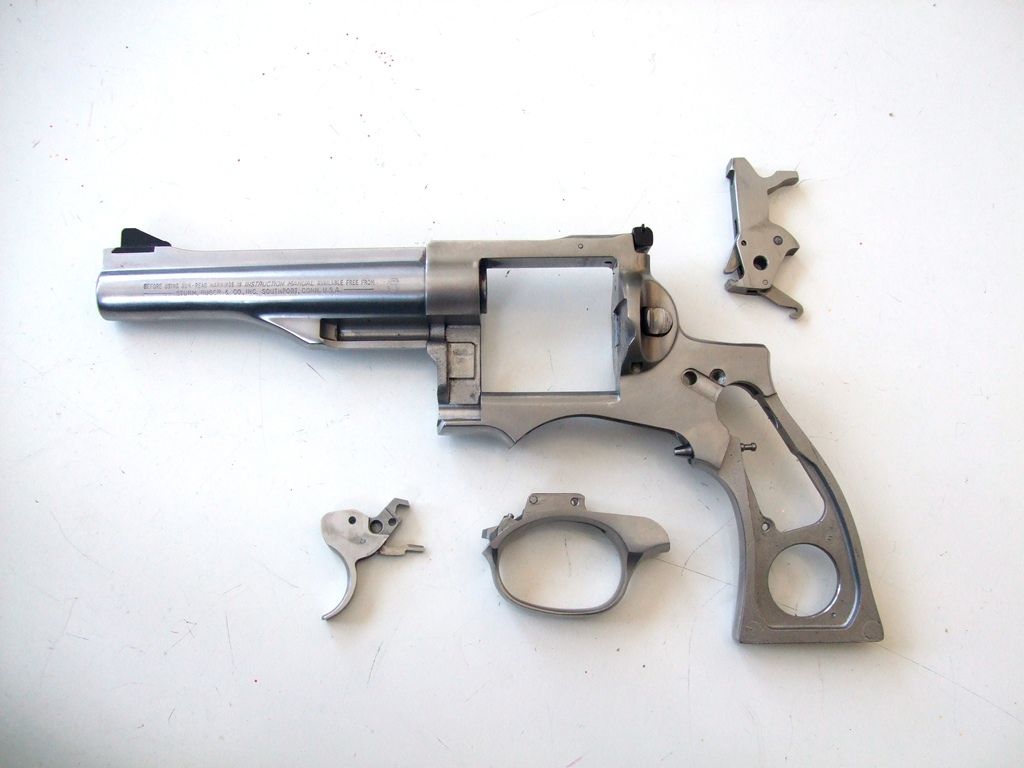 Frame opening in "solid" frame for modular trigger guard eliminates need of a sideplate to access lockwork. Unlike a sideplate frame, solid frame of Redhawk absorbs stress symmetrically. 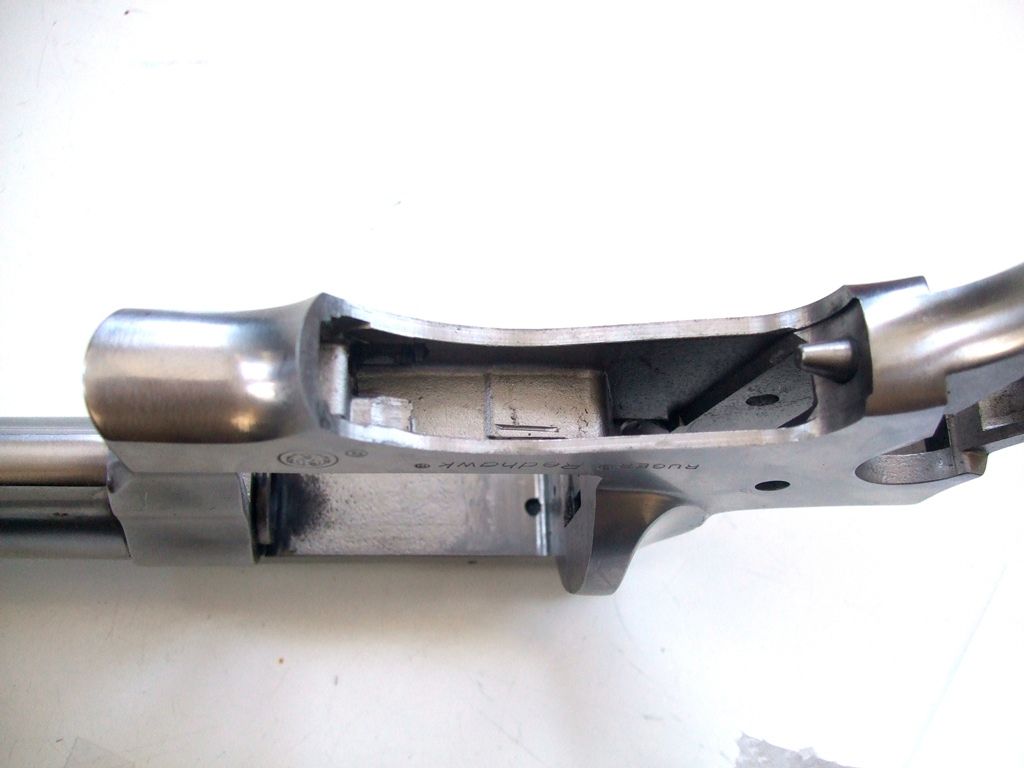 Massive cylinder spins on a massive investment cast crane. Non-rotating ejector is below cylinder axis, proving room for thicker barrel stub and frame socket. Crane is held in frame by trigger guard. 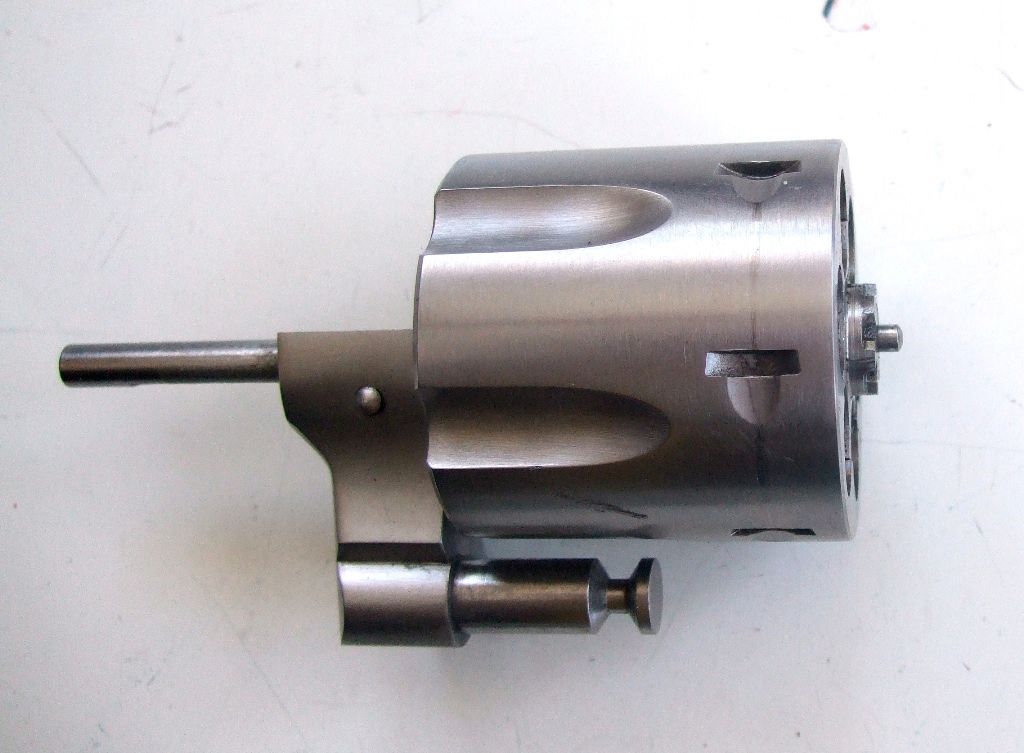 Clearance for thick barrel stub and frame ring, made possible by locating ejector below cylinder axis. 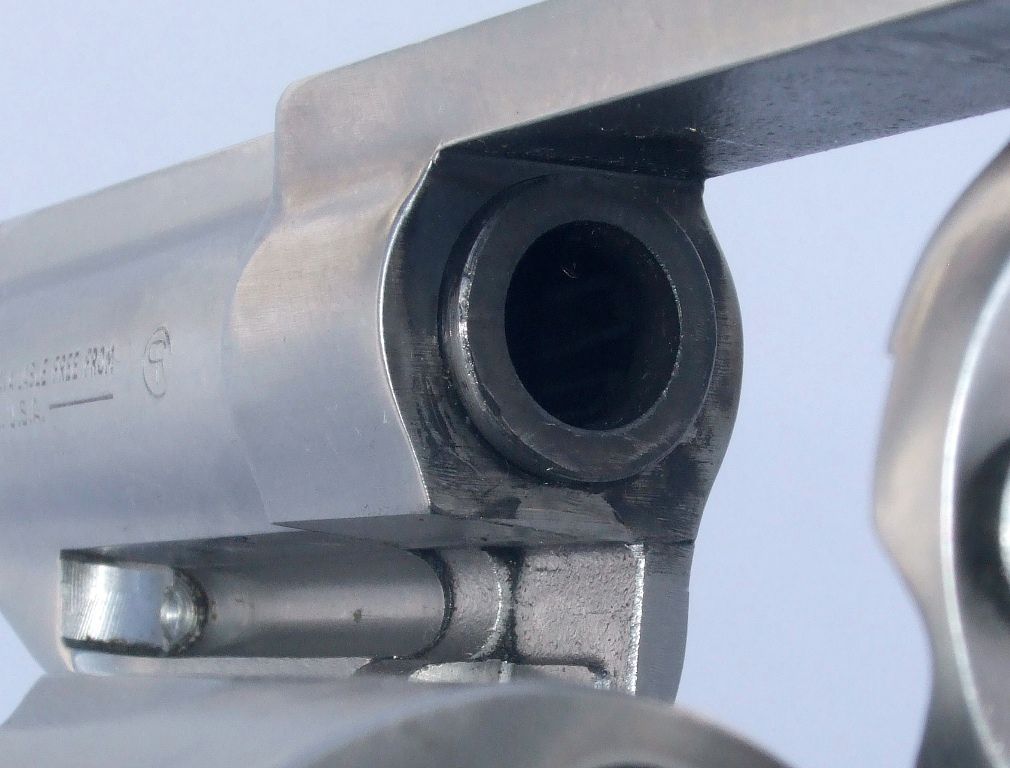 Redhawk crane latch imparts by far strongest lockup any DA, most welcome with heavy bullets and heavy loads.  Along with thicker barrel mounting, offset ejector helps to keep Redhawk compact for its power potential. 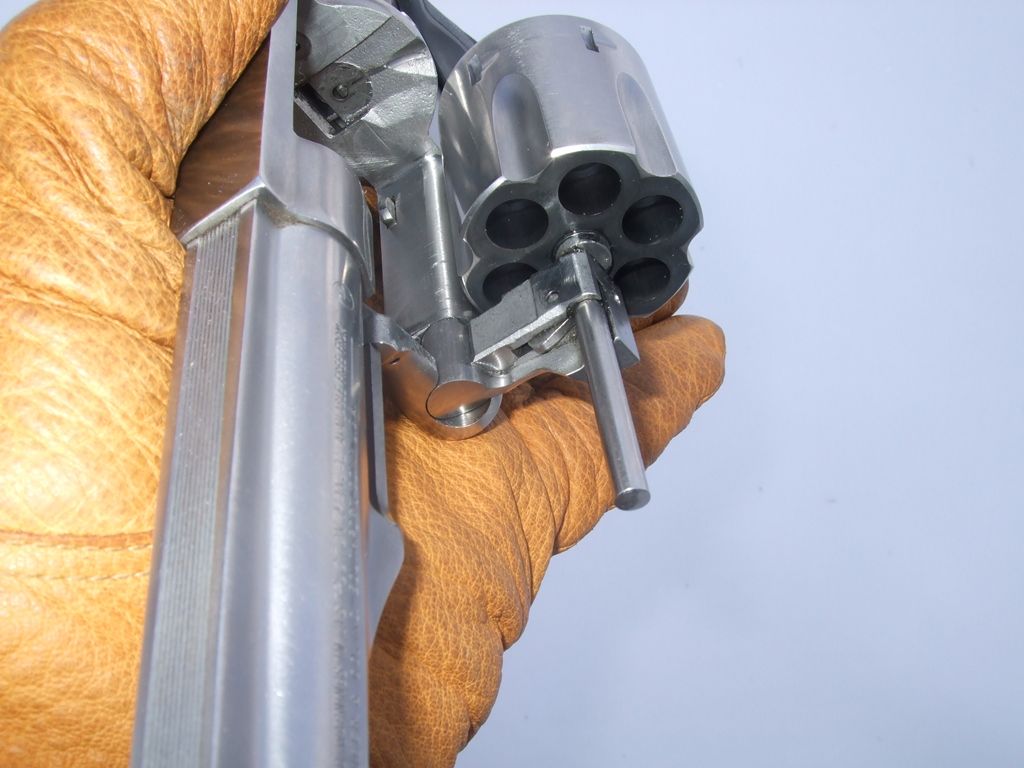 Trigger module mounts trigger, pawl, transfer bar, and cylinder latch. Assembly strips vertically from frame. Pawl and transfer bar mount to trigger. 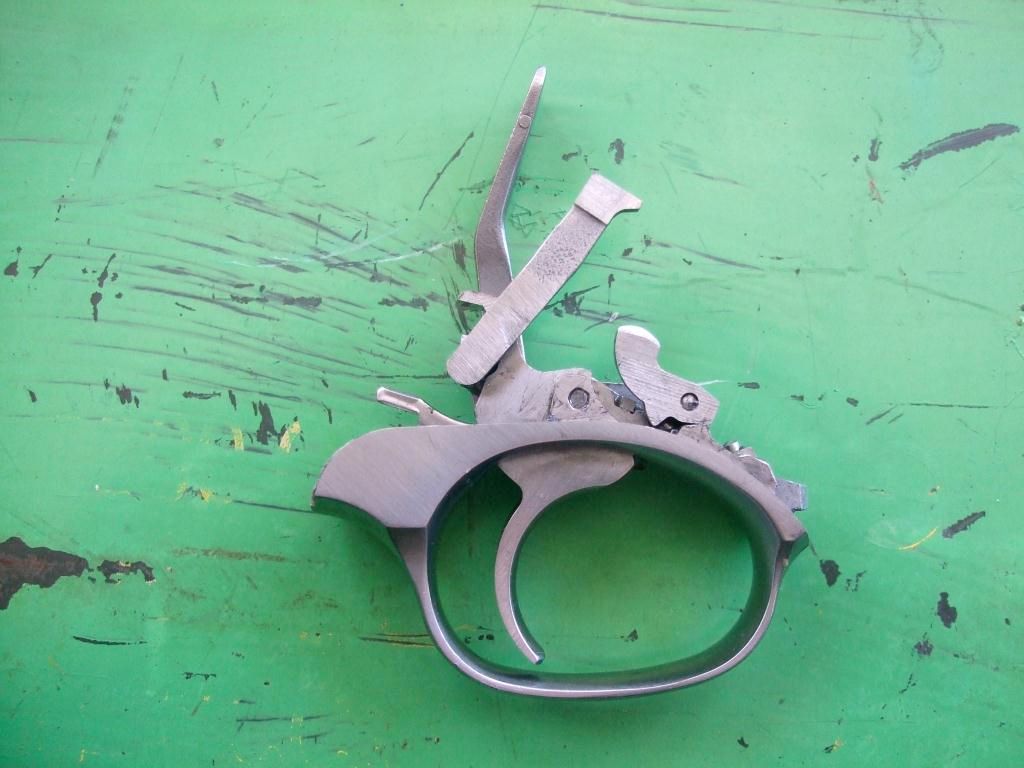 Massive cylinder latch, for several reasons strongest of any double action. Latch pivots without oscillation on a wide base, engages offset notches in cylinder. 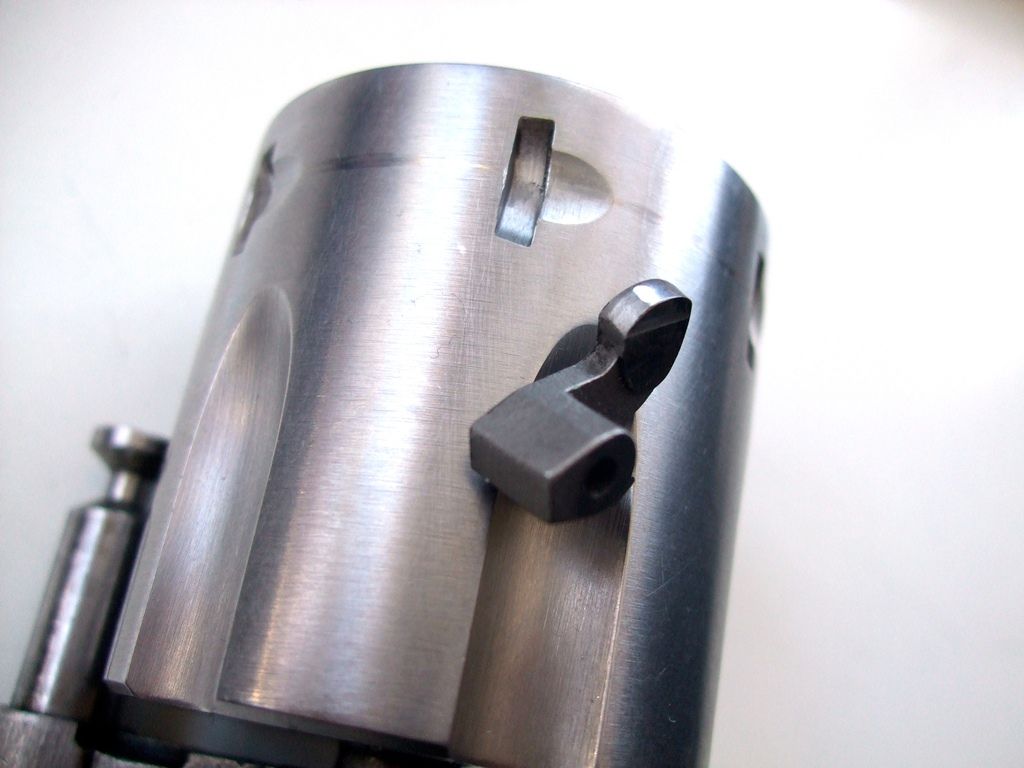 Cylinder latch with plunger and spring. Containment in trigger module provides room for spring assembly without cramping. Strong spring in conjunction with non-oscillating latch insure positive cylinder lockup and resistance to timing problems. 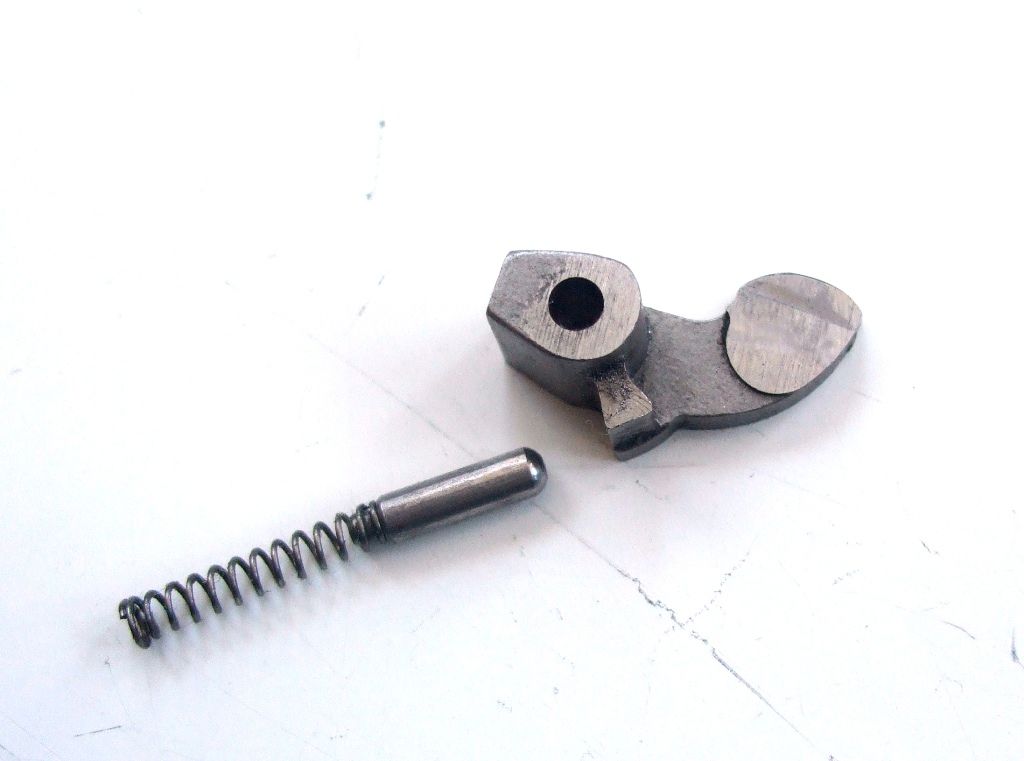 44 Mag Redhawk cylinder. Note offset latch. 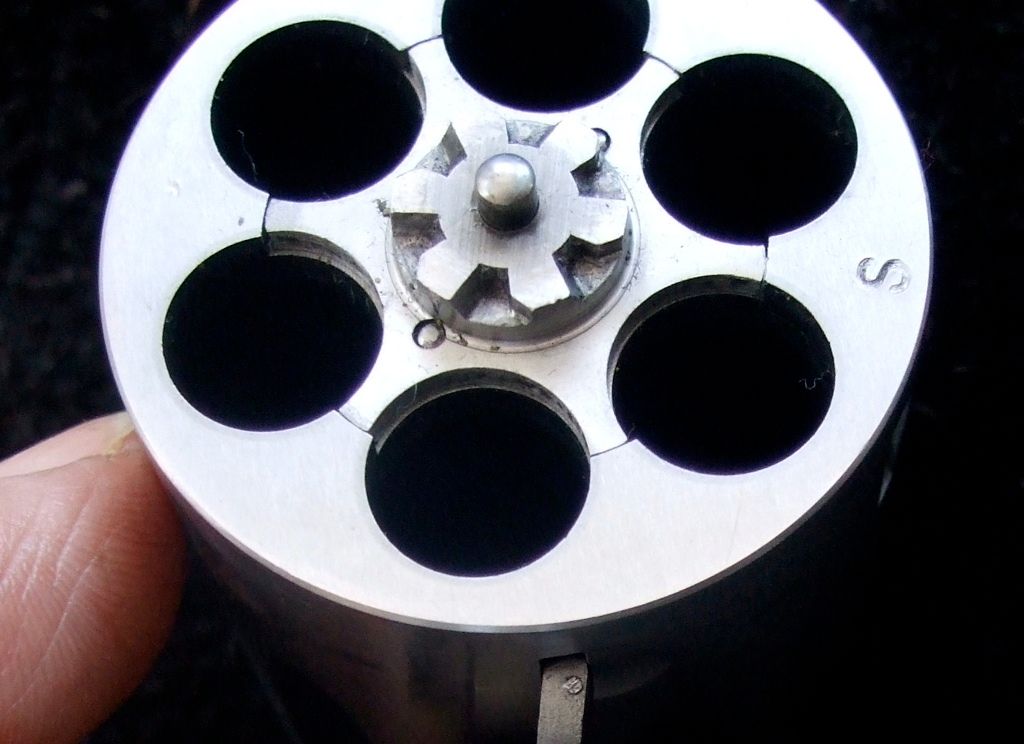 Redhawk on thrown water jug soon after release of 5-1/2" bbl in 1982. Federal .44 Mag 180 JHP @ 1610 fps. Next stop: a look at the Redhawk trigger. 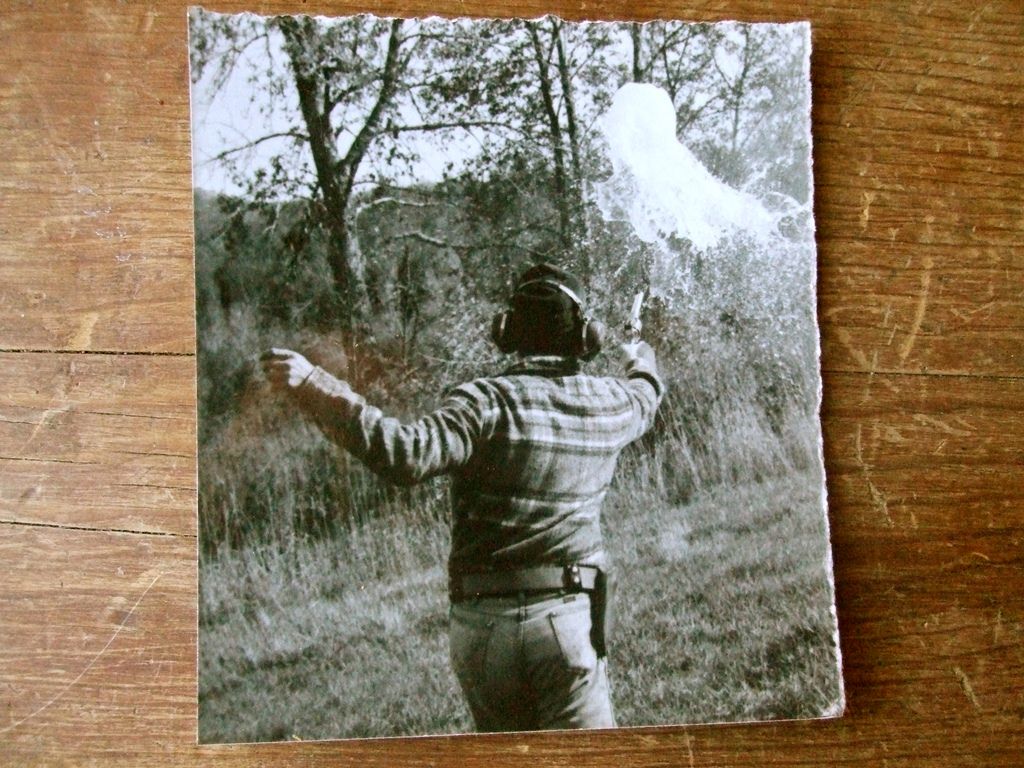 -Lee www.singleactions.com"Building carpal tunnel one round at a time" |
|
|
|
Post by bradshaw on Mar 10, 2015 13:17:20 GMT -5
Beaucoup thanks to Lee Martin for posting these pieces.
The Redhawk is a firearm that sustains the deepest inspection and comes through as a masterpiece of sound construction. This, in the age of hair raising shortcuts. Bill Ruger was always looking to make one part do two jobs, a hallmark of sound design. In adopting the Colt Python concept of powering hammer and trigger with the same spring, he went too far. Unlike the Python, however, the Redhawk spring is rough & tumble durable. This is not a gun shy about its strength. It is red meat strong inside as out.
David Bradshaw
|
|
cmh
.401 Bobcat
  
Posts: 3,745
|
Post by cmh on Mar 10, 2015 14:27:15 GMT -5
Mr Bradshaw, while not knowing Mr Ruger personally could I ask was he a engineer or just one of those brilliantly self taught individuals? How did he become such a cornerstone of the firearms community? Lots of folks have come up with one good idea but good Lord he came up with alot of them that continue to just plain work  |
|
|
|
Post by hoover on Mar 10, 2015 14:36:49 GMT -5
An excellent explanation on why I love Redhawks! Bill Ruger built them to last at working man prices!
|
|
|
|
Post by bradshaw on Mar 11, 2015 10:39:43 GMT -5
cmh.... safe to say an inquisitive, analytical mind propelled William B. Ruger to learn how things work, how to design them, how to make them, how to manufacture them. Believe he worked to design a machine gun while in college. Worked for arms manufactures during the war. Had a dog's nose for arms that would excite shooters following the war. I saw him as a natural engineer with x-ray vision, a powerful conceptualist. Ruger could not have implemented his ideas without lost wax casting, and he is a main instigator of its widespread use today.
I find it curious that lawyered-up critics of Ruger single actions built on the the Colt Peacemaker lockwork, critics who accuse Ruger of building a reviolver "faulty be design," have never themselves invented another lockwork, let alone come up with lockwork better than Ruger's New Model transfer bar passive safety system, and do it sooner than Ruger. Further, every lawsuit of which I am aware depends at its core absolving the person in contact with the firearm of the first rule of firearms handling----MUZZLE CONTROL----whether that person shoots himself or herself, or another.
Don't let me go down that path; you asked about the genesis of Ruger's focus and talent. I'm not the authority. Ruger shared a couple of the attributes of John Moses Browning: x-ray vision of mechanics and a dog's nose for practical and handsome hardware.
David Bradshaw
|
|
cmh
.401 Bobcat
  
Posts: 3,745
|
Post by cmh on Mar 11, 2015 10:43:30 GMT -5
|
|
|
|
Post by bradshaw on Mar 11, 2015 10:44:10 GMT -5
Tank.... reckon you're a Redhawk kind of man.
David Bradshaw
|
|
|
|
Post by hoover on Mar 11, 2015 12:06:27 GMT -5
David, I like 'em all! But the Redhawk does hold a special place in my heart! Here is one of mine taken during a spring black bear hunt with Doc and sixshot in Idaho. 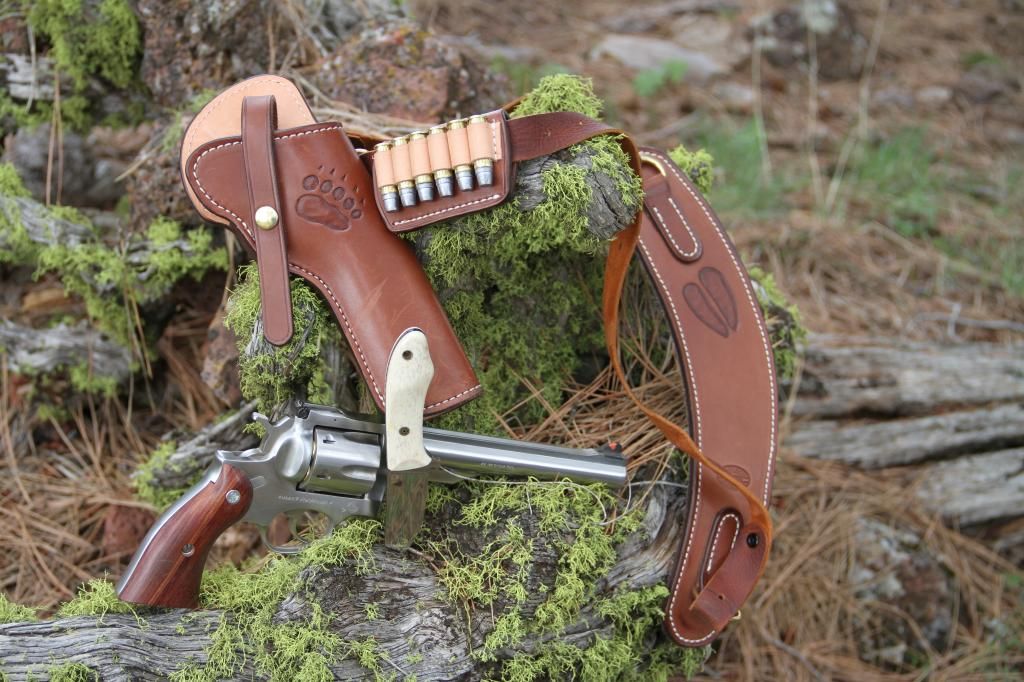 |
|
|
|
Post by bradshaw on Mar 12, 2015 4:40:20 GMT -5
Tank.... strange, how I didn't much notice recoil of .44 mags from the original 7-1/2" barrel; yet, upon shooting the 5-1/2" quickly slapped on a Pachmayr. Reckon one of these days I'll try an Uncle Mike's, which made an excellent grip----somewhat more compact than the Pachmayr----for the SRH.
David Bradshaw
|
|
|
|
Post by hoover on Mar 12, 2015 8:48:21 GMT -5
David, I have been blessed/cursed with pretty large, meaty paws. Blessed in that they seem to be made to contort themselves around most stocks comfortably in a choke hold, cursed in that they are not conducive to picking up small items such as small gun screws and springs. I also have 4" RH's in .44 and .45, along with my favorite length 5.5" in .41 and .44 . The 4" .44 was given to me by some special friends. And the 5.5" was acquired years ago from a Ruger rep when he was in my area and saw fit to straddle a median strip late one night and was grateful for the assisstance rendered  . I stripped the rubber grips that came with the new 4" guns and replaced with the standard issue wood stocks. They just seem to feel better to me. |
|
|
|
Post by bigmuddy on Mar 12, 2015 9:33:09 GMT -5
The Redhawk is undoubtably one of my favorite revolvers. Remembering seeing and holding my first one in a gun shop in St.Joseph MO and thinking "some day". Many here probably remember the scalper prices these guns were bringing when it was new. At that time I heard of a Redhawk being raffled at a shop in IA. I drove an hour to get there to get my ticket. I found to my dismay that the raffle tickets that were $5 got the winner the gun.....for $500.00!
Finally got one at regular retail price in 1982, a 7.5". What a fantastic gun. I never thought I would need or want anything else. How my wife wishes that were true. A little over a year later I saw a gun in a case that I had not heard of at all.... A 5.5" Redhawk. I promptly traded my long barreled gun for this one and still have it today. Mine is like David's in that the hammer pin is on the "wrong" side. I later read in a magazine that this was the case with all of the 5.5" guns but they were changed back shortly thereafter. Not sure how many have these pins but was told by a Ruger collector that they are considered rare. Mine has so many battle scars it sure would not be considered a collector. Got my first handgunned deer with that gun.
I jumped on a 4" gun when they were first available. Only Redhawk I've I had that I didn't warm up to. The recoil on that gun was brutal to say the least. Much worse than a 4" Smith 29. I wonder now if it maybe had tight chamber throats but for some reason it beat me to death. I also found it no easier to carry than my beloved 5.5" gun so I let that one go.
Dan
|
|
|
|
Post by bradshaw on Mar 12, 2015 10:50:57 GMT -5
Dan.... about the only things Ruger copied from the M-29 on the Redhawk were the cartridge, counter-clockwise carry-up, and S&W N-frame grip profile, albeit thicker straps and with the shoulder higher up the backstrap. A .004-inch feeler cannot pass through cylinder gap of my 5-1/2", which, contributes to high velocities.
Appreciate your observation on comparative recoil from your 4" Redhawk.
David Bradshaw
|
|
|
|
Post by bradshaw on Dec 30, 2018 19:10:53 GMT -5
Alaska454 and Dan.... note hammer hook, with claw facing down. Ruger installed the mainspring hook two ways----facing down and facing up, settling (as I recall) on the claw facing up. The reason, ostensibly, was to prevent the claw from unhooking the mainspring. Having not encountered this problem, I think the real reason may have been to ease assembly. Note also: hammer this Redhawk from 1982 has the flange for the HAMMER PIVOT on the left side of frame. Production waffled briefly, then settled on the pivot flange on the right. Since many grips are scalloped on the left side to clear a speed loader and ease extraction, and the flange relies on the grip to hold it in place, it is better for the pivot flange to be on the right.
David Bradshaw
|
|






























